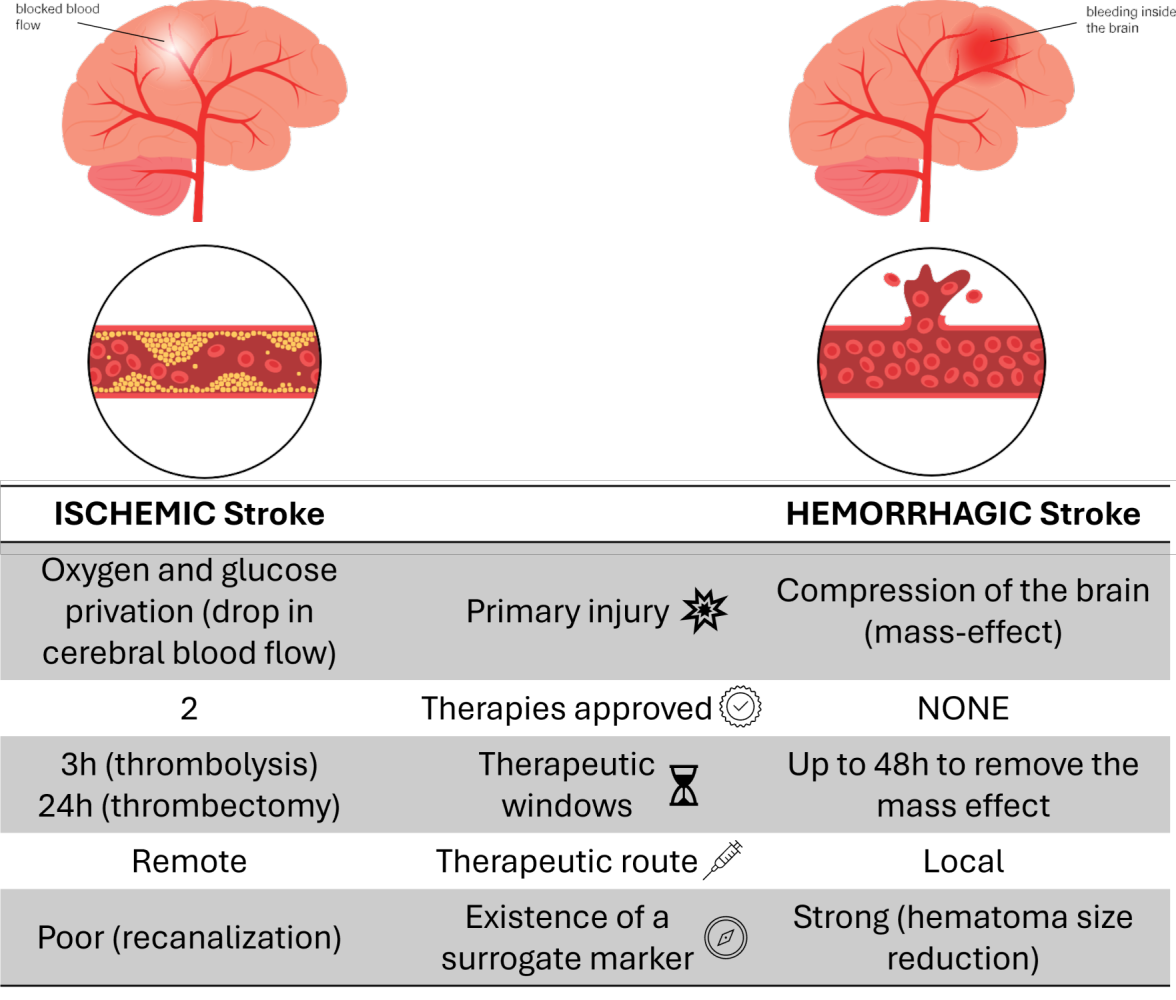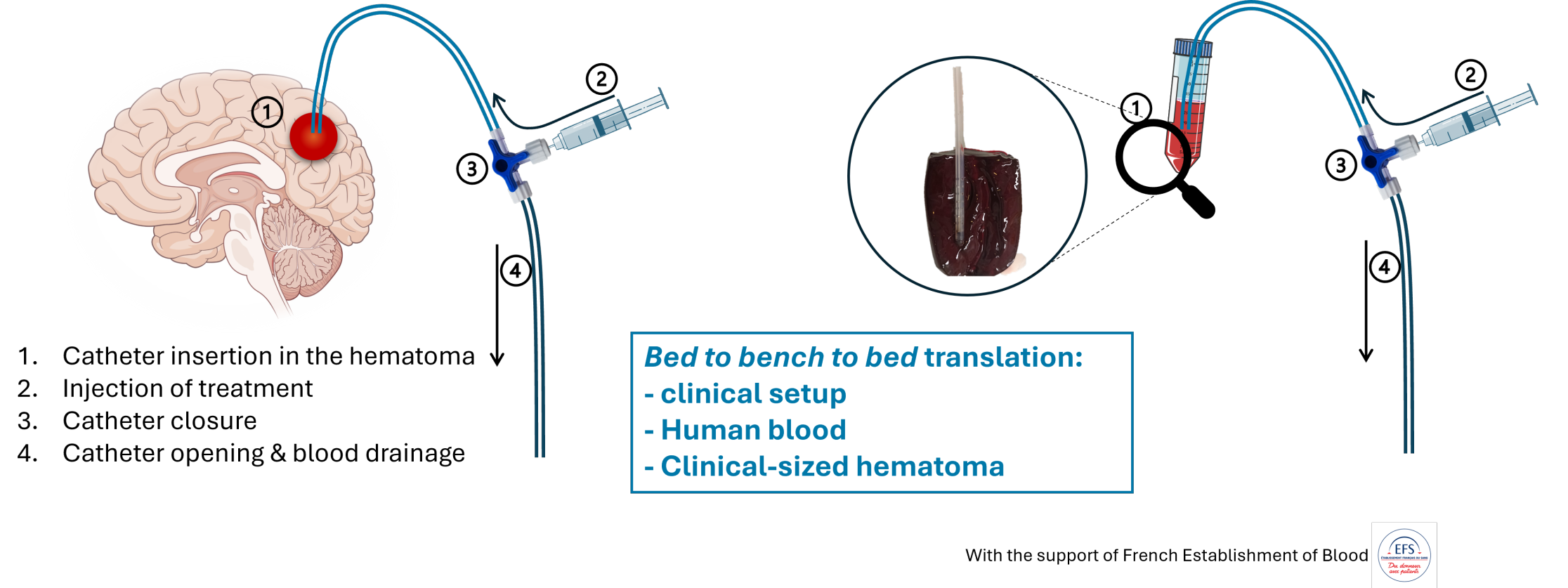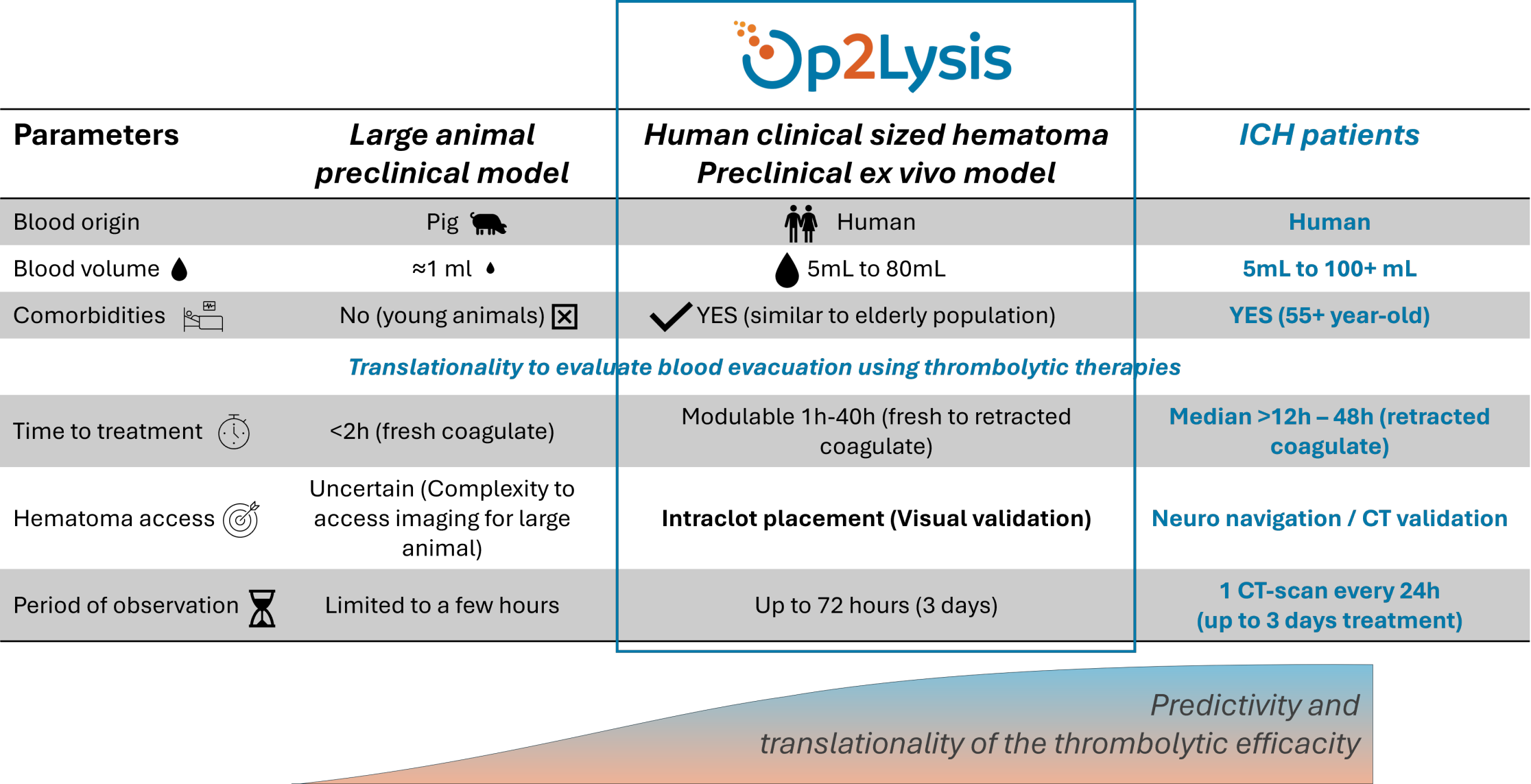1. Hemorrhagic Stroke: Understanding to Act Quickly and Effectively
Did you know that while hemorrhagic strokes account for only 15% of all strokes, they are responsible for nearly 40% of stroke-related deaths?
On this World Stroke Day, let’s take a closer look at this life-threatening medical emergency.
What is a Spontaneous Hemorrhagic Stroke (Intracerebral Hemorrhage – ICH)?
A hemorrhagic stroke occurs when a blood vessel in the brain ruptures, causing bleeding. This bleeding increases pressure on brain tissues, leading to cell damage. Common causes include high blood pressure and vascular abnormalities.
Recognizing Stroke Symptoms: F.A.S.T. Method
Whether hemorrhagic or ischemic, recognizing stroke symptoms quickly is crucial. Use the F.A.S.T. acronym to remember the signs:
- F = Face Drooping: Is one side of the face drooping or numb? Ask the person to smile—does it appear uneven?
- A = Arm Weakness: Is one arm weak or numb? Ask the person to raise both arms—does one drift downward?
- S = Speech Difficulty: Is speech slurred or hard to understand?
- T = Time to call Emergency: Every minute counts in a stroke. Call 911/112 immediately and note when symptoms first appeared.

Ischemic vs. Hemorrhagic Stroke: Key Differences
Unlike ischemic stroke, which is caused by a clot blocking blood flow in the brain, hemorrhagic stroke results from a blood vessel rupture, leading to bleeding in the brain and compression of brain tissue. Treatment strategies for these two stroke types differ significantly and must be determined after brain imaging. Indeed, while there are two different strategies for ischemic stroke, there is no approved treatment for hemorrhagic stroke. ICH is an unmet medical need.

Differences Between Ischemic and Hemorrhagic Stroke. Key distinctions between ischemic and hemorrhagic strokes, the two main forms of stroke: Ischemic Stroke, due to a reduction of cerebral blood flow, leads to subsequent brain cell damage. 2 strategies approved. Poor bench to bed translation; Hemorrhagic Stroke, due to blood vessel rupture, leads to the formation of a hematoma and mass effect. No treatment approved. Strong surrogate marker.
Trends and Economic Impact
With an aging population, especially in high-income countries, the number of hemorrhagic stroke cases is expected to rise. The cost of care in the first 12 months post-event exceeds €50,000 per patient, inducing immense pressure on healthcare systems.
Conclusion: The Importance of Prevention and Rapid Response
Early recognition of stroke symptoms and timely action are essential for saving lives and brain function. Unfortunately, no approved treatment exists for hemorrhagic stroke. At Op2Lysis, we are committed to developing innovative solutions to address this unmet medical need and improve patient outcomes.
Hemorrhagic stroke is a medical emergency distinct from ischemic stroke. Despite its severity, there is currently no approved treatment to address this critical need.
2. Translational Research at Op2Lysis: Turning Innovation into Solutions for Hemorrhagic Stroke

How can we improve the lives of hemorrhagic stroke (ICH) patients?
We are at the forefront of a new era in hemorrhagic stroke care. The past five years have brought significant breakthroughs in our understanding of hemorrhagic stroke. One critical insight is that reducing the size of the hematoma is essential for improving patient outcomes and reducing both death and disability.
How can hematoma size be reduced?
There are two key strategies: stopping the bleeding or removing the hematoma. Stopping the bleeding is currently addressed through measures like reversing anticoagulation and controlling blood pressure. However, these treatments are only effective if administered very quickly—within the first few hours of the stroke (hyperacute phase).
At Op2Lysis, we are focusing on the acute stage, up to 48 hours after the stroke occurs. Our goal is to develop a novel therapeutic solution to safely remove intraparenchymal hematomas, offering treatment options to a broader population of patients who fall outside the hyperacute window.
From Research to the Clinic: Ensuring Success with Translational Research
At Op2Lysis, we believe that translational research is the most effective path to transforming scientific discoveries into real-world treatments for hemorrhagic stroke. Our approach goes beyond the laboratory, with extensive collaboration with clinical centers to test and refine our therapies. This ensures a smooth and reliable transition from research to clinical application.

Bed to bench to bed strategy of Op2Lysis to better anticipate O2L-001 candidate efficacy in future clinical trials
Thanks to the support of the French establishment of Blood (EFS) and the Caen Hospital, we have developed an advanced translational model that uses human blood to replicate large, deep-seated hematomas. By leveraging surgical expertise and materials, we have demonstrated the significant potential of our treatment. This cutting-edge model enables us to assess the effectiveness of our therapies in conditions that closely mimic real-world clinical scenarios.

Positioning of preclinical models in bench-to-bedside translation. For good haematoma evacuation in the treatment of ICH, the clinical size human blood haematoma is more predictive and allows better definition of the conditions of use.
Conclusion
Through our unwavering commitment to translational research, Op2Lysis is transforming scientific discoveries into concrete solutions for hemorrhagic stroke patients. Follow our page to stay up to date with the latest advancements and how we’re changing the future of stroke care.
At Op2Lysis, we turn groundbreaking research into real solutions for hemorrhagic stroke.
3. The Future of Hemorrhagic Stroke Management: Innovations and Challenges

A New Era in Hemorrhagic Stroke Care
The management of intracerebral hemorrhage (ICH) has entered a promising new phase, with emerging options showing significant potential for improving patient outcomes. Two recent clinical trials, INTERACT-3 and ENRICH, have provided the first positive steps toward better care for ICH patients.
In the INTERACT-3 trial, involving over 7,000 patients, a comprehensive care bundle was implemented in the acute phase of hemorrhagic stroke. The trial demonstrated that early and aggressive blood pressure management significantly reduced death and disability rates. On the other hand, the ENRICH trial, which involved 300 patients, showed that minimally invasive, device-assisted removal of superficial hematomas can also reduce mortality and improve functional outcomes in these patients.
Remaining Challenges
Despite these promising developments, several hurdles remain. First, the benefits seen in INTERACT-3 cannot be fully realized in pre-hospital settings, such as in ambulances, because the diagnosis of hemorrhagic stroke often cannot be made before hospital admission. The upcoming INTERACT-4 trial, which did not yield conclusive results, underscores the need for more research into early, accurate diagnostics of hemorrhagic stroke with both high sensitivity and specificity.
Secondly, while ENRICH produced positive results for superficial hematomas, no benefit was observed in patients with deep hematomas, which account for more than two-thirds of hemorrhagic strokes. This highlights the need for new strategies specifically targeting deep-brain hematomas, a much larger subset of patients.
A Breakthrough in Deep Brain Hematoma Treatment
At Op2Lysis, we are pioneering a drug-based solution for the removal of deep-seated intracerebral hematomas. Our lead candidate, O2L-001, offers a minimally invasive approach to microsurgical deep hematoma evacuation. The key advantage of this treatment is that it requires no additional equipment for neurosurgeons, making it highly scalable and accessible. Preclinical results published in Brain* have demonstrated excellent efficacy, and with over 15 years of foundational research, O2L-001 offers a compelling benefit-risk profile. This treatment should drastically improve outcomes for the majority of hemorrhagic stroke patients.
Conclusion
Recent advancements in both medical devices and pharmacological research are creating a brighter future for hemorrhagic stroke management. From innovative surgical techniques to groundbreaking drug therapies, the field is on the cusp of transformative change. At Op2Lysis, we remain at the forefront of this innovation, working to address the unmet needs in hemorrhagic stroke care.
Continuous innovation is essential to improving the management of hemorrhagic strokes.
To learn more about our research and advancements, follow our page
——
*. Audrey M Thiebaut, Estelle R Louet, Mélina Ianszen, Marie-Julie Guichard, Daniel F Hanley, Christophe Gaudin, Jérôme Parcq. O2L-001, an innovative thrombolytic to evacuate intracerebral haematoma, Brain, Volume 146, Issue 11, November 2023, Pages 4690–4701. https://doi.org/10.1093/brain/awad237

Leave a Reply